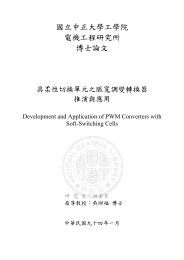Syntax of the Bi Comparative Construction in Mandarin Chinese
Syntax of the Bi Comparative Construction in Mandarin Chinese
Syntax of the Bi Comparative Construction in Mandarin Chinese
You also want an ePaper? Increase the reach of your titles
YUMPU automatically turns print PDFs into web optimized ePapers that Google loves.
<strong>Syntax</strong> <strong>of</strong> <strong>the</strong> <strong>Bi</strong> <strong>Comparative</strong> <strong>Construction</strong> <strong>in</strong> Mandar<strong>in</strong> Ch<strong>in</strong>ese<br />
b. [xiangjiao yu Zhangsan], wo hen pang<br />
<strong>in</strong> contrast to Zhangsan I very fat<br />
‘Compare to Zhangsan, I am very fat.’<br />
c. [xiangjiao yu Lisi], wo buhui hen pang<br />
<strong>in</strong> contrast to Lisi I not very fat<br />
‘Compare to Lisi, I am not very fat.’<br />
In (111 ), whe<strong>the</strong>r <strong>the</strong> degree <strong>of</strong> I am fat is relative to some comparative datum which<br />
may be absent <strong>in</strong> it PF. Likewise, BCC that belongs to explicit comparatives are <strong>of</strong><br />
this case, too. As we can see <strong>in</strong> (112), <strong>the</strong> comparative datum is explicit, and <strong>the</strong><br />
degree adverb <strong>of</strong> BCC is geng. The <strong>the</strong> degree head s-selects a comparative bi-clause<br />
to be one <strong>of</strong> its complements. And as we have discussed <strong>in</strong> Section 3.1.2, bi has <strong>the</strong><br />
mean<strong>in</strong>g <strong>of</strong> comparison historically, thus <strong>the</strong> comparative degree adverb geng is <strong>of</strong>ten<br />
covert <strong>in</strong> PF.<br />
(112) Explicit <strong>Comparative</strong>s (BCC)<br />
a. wo [CPbi Zhangsan pang] geng pang<br />
I COM Zhangsan fat more fat<br />
‘I am fatter than Zhangsan.’<br />
3.3.2 Co-occurrence Restriction Between bi And geng<br />
Accord<strong>in</strong>g to Li and Thompson (1981), CC <strong>in</strong> Mandar<strong>in</strong> can be divided <strong>in</strong>to three<br />
types. With respect to <strong>the</strong> different degrees <strong>of</strong> <strong>the</strong> dimension, one item can be more<br />
than <strong>the</strong> o<strong>the</strong>r (<strong>the</strong> superior degree), less than <strong>the</strong> o<strong>the</strong>r (<strong>the</strong> <strong>in</strong>ferior degree), or <strong>the</strong><br />
same as <strong>the</strong> o<strong>the</strong>r (<strong>the</strong> equal degree). In <strong>the</strong> follow<strong>in</strong>g examples, bi and geng <strong>in</strong> (113a),<br />
mei(you)/buru and name <strong>in</strong> (113b), and also gen and yiyang <strong>in</strong> (113c) have some<br />
66<br />
中正大學 e-Thesys (94 學年度)





